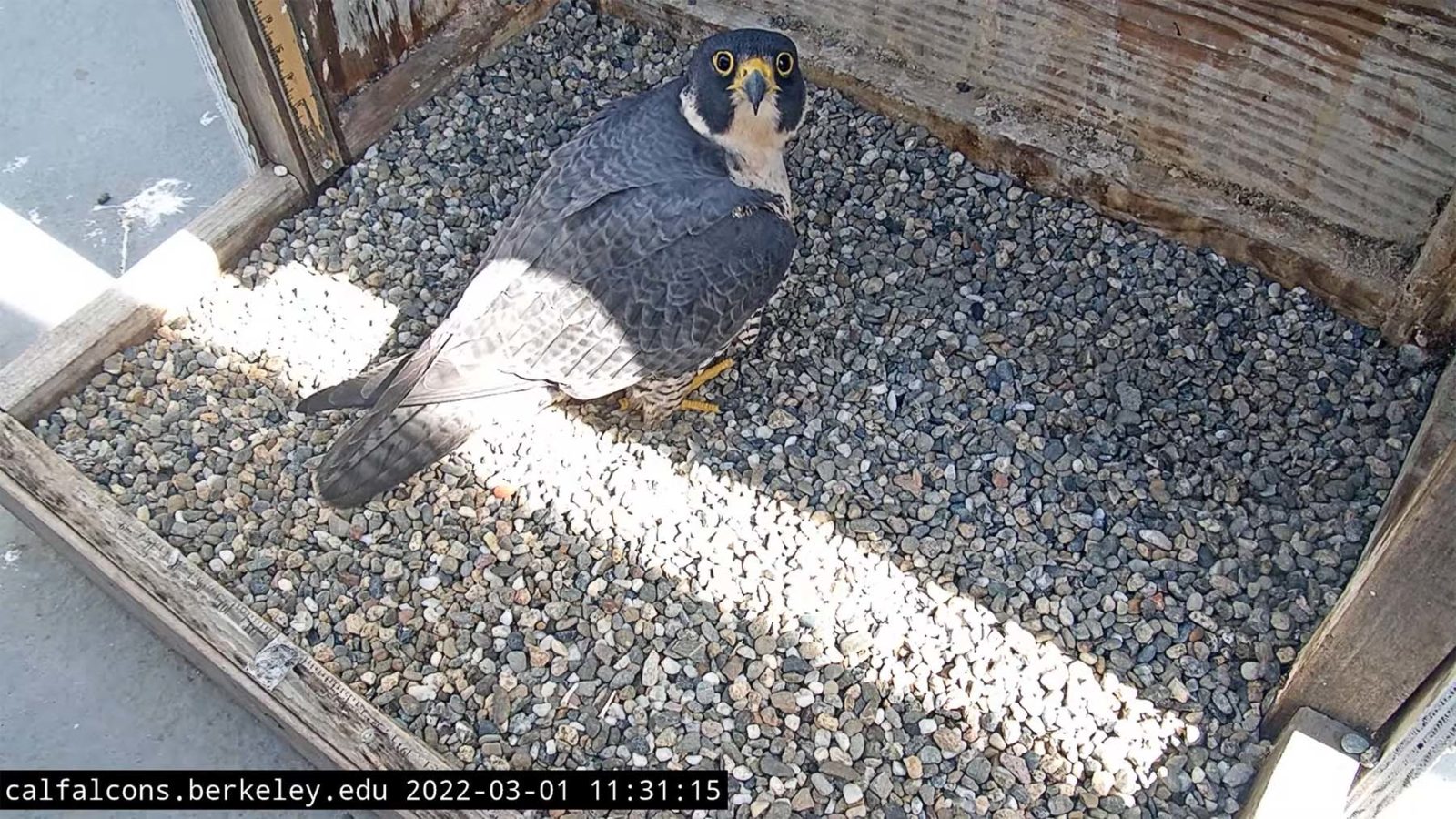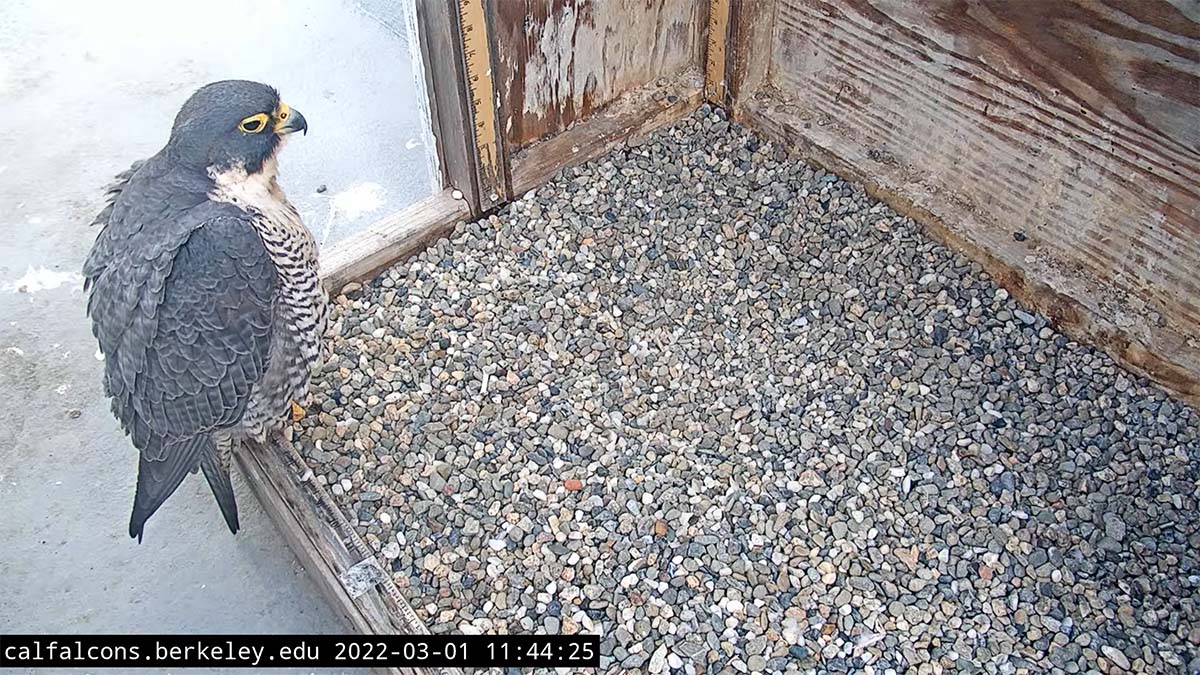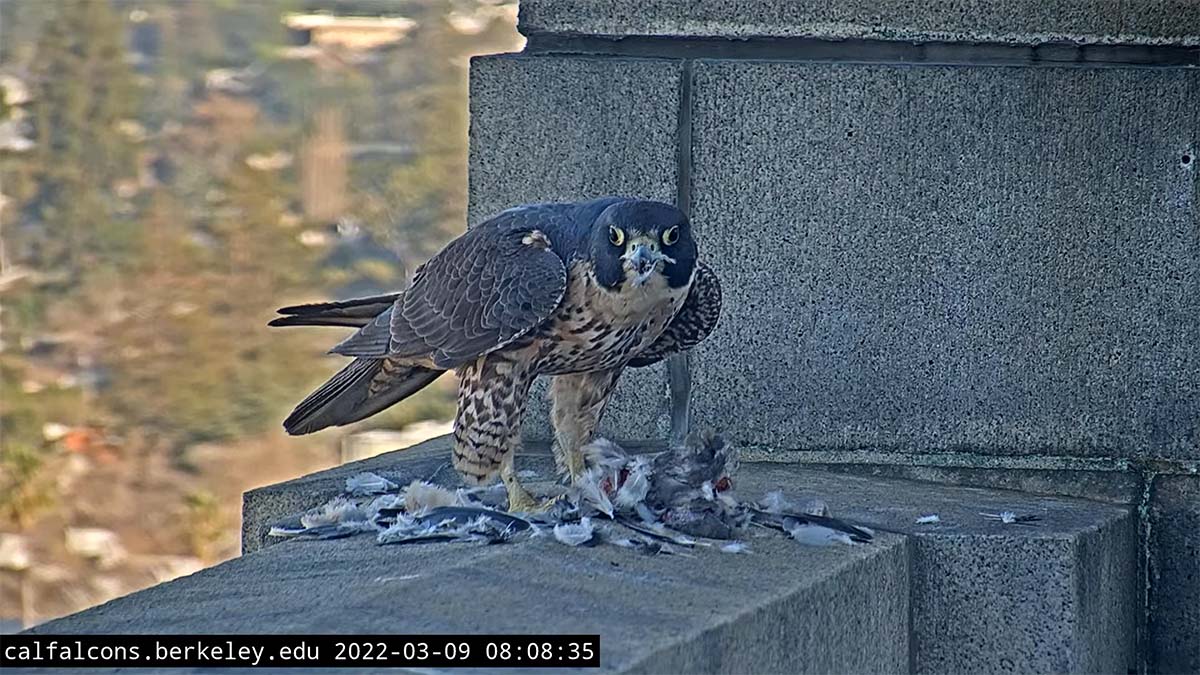
On Monday, Feb. 21, Mary Malec, a nest site monitor with the team that watches the peregrine falcons of UC Berkeley’s Sather Tower, spotted the falcon matriarch Annie perched on the side of her tower-top nest box. It was the last anyone would see of Annie for a while.
Two days later several “floaters” – non-breeding peregrine adults that seek out new territories – landed on the Campanile, something Annie would likely have not allowed had she been around. Late winter and spring is the falcons’ breeding season, and in past years at this time, Annie has been in the tower almost constantly. Her multi-day absence, leaving the territory more vulnerable to interlopers, was highly unusual.
The experts at Cal Falcons, the group that has installed web cams to share the lives of these birds, were starting to reach a disquieting conclusion: Annie was gone.
“The fact that four floaters came by … and sat on the ledges and stayed … it’s a very clear indication that Annie wasn’t there to chase them off,” Malec said. “So, I think that was the first clue that something wasn’t quite the way it should be.”
The Cal Falcons team watched the falcons that approached Sather Tower, and went out on foot to check Annie’s known perches around the campus and city. The search turned up nothing, and meanwhile Grinnell, Annie’s mate of the last five years, seemed to be moving on.
“Grinnell is more of a bird expert than we are, and he even started courting a new female,” said Lynn Schofield, a Cal Falcons ornithologist and one half of the duo, with her ornithologist husband Sean Peterson, behind the Cal Falcons media sensation. One of the floaters, a juvenile female, had been seen checking out the nest box roughly one week after Annie was last seen and was also spending hours with Grinnell – a sign that, perhaps even with Annie out of the picture, there might still be chicks raised in the Campanile this year.

“I think people have this kind of human-centric view of how individuals would react,” Peterson said. “If it was a human who lost their wife, there would be a period of mourning before you look for a new mate – there isn’t for peregrines.”
The Cal Falcons have a loyal internet following, and regulars had also started to notice the shifting dynamics at the top of Sather Tower. By Sunday, Feb. 28, Schofield and Peterson decided it was time to tell everyone what they knew. “Unfortunately,” they wrote on social media, “we believe that Annie has either been displaced from the territory, is injured or dead.”
“We didn’t want to cause people distress or anything like that,” Peterson said. “So we did wait as long as we thought we should — and could — until saying anything. But Grinnell was kind of forcing our hand by taking up with this new female.”
Peterson also made it clear that Grinnell “has like zero control over what’s going on.” Male peregrine falcons are far smaller than the females, and Peterson explained that “a female peregrine falcon could easily, easily kill a male if it wants to.”
Fans who have followed the falcons from around the world responded to the announcement with grief. “We had been sitting on the knowledge that, you know, Annie was almost certainly gone for several days, so I had several days of feeling pretty bummed out,” Schofield said. “And then announcing it and seeing other people’s reaction really was hard.”
Peterson said some of the hardest comments to read were those written by teachers explaining that they had to tell their elementary school students about Annie’s disappearance. Peterson likened the Cal Falcon team’s role after they broke the news to “almost acting like a biological grief counselor” for distraught Cal Falcon fans, seeking to “keep them informed of the biology and the ecology of what’s going on, and then allowing people to grieve.”
“We knew it was coming, and we tried to kind of let people know that it was gonna happen, but it doesn’t change the fact that it hurts like hell when it does,” Peterson said.
Then, around 23 hours after Annie’s disappearance had been announced and over a week after she had last been seen, Peterson was working on his computer in his New York home office with the Cal Falcon web cameras on in the background. He happened to look over and saw “a bird sitting right where Annie likes to sit,” he said. “I zoomed in as quick as I could and just immediately recognized it was Annie, because, I mean, the other birds have just not looked like her at all – she’s fairly distinctive, and we’ve probably collectively looked at her for thousands of hours.”
Peterson ran to Schofield’s office to check with her, then texted the Cal Falcon monitors’ group chat to tell them the news. Malec was sitting on a hill near Livermore and observing another bird nest at the time of Peterson’s text, and she said that after receiving the text, “I almost packed up and got in the car and drove back.”
Within minutes, Peterson had posted the joyous correction across all Cal Falcon social media platforms. “Annie is BACK,” the team wrote on their Cal Falcons Instagram post. “We apologize for this emotional roller coaster. This is something we’ve *never* seen before.”

Cal Falcons fans – and the ornithologists themselves – swung from grief and rationalization to joy and disbelief. “It’s like an inverse of a normal roller coaster,” Peterson said. “It’s a long decline, feeling sad, and then all of a sudden – right to the moon with like, ‘Oh my God, I was wrong and we were all wrong?!’ It’s hard to describe that feeling-switch, not quite believing your eyes at first and being like, ‘OK, I’m not wishful-thinking, turning another bird into Annie – that is Annie.’”
Malec, who has observed countless peregrine nests and was the first to detect Annie and Grinnell’s nesting behavior when their pair first nested at the Campanile in the spring of 2017, said, “We were still just as mystified but feeling a whole lot better – at least she’s alive.”
“I do feel bad that we caused people distress and emotional whiplash over two days,” Peterson added. But given Annie’s absence during the height of the breeding season, all the signs pointed to an inevitability that was only negated by her miraculous return.
Still, even with the knowledge that Annie isn’t dead, life at the top of Sather Tower hasn’t fully returned to normal. Since she first reappeared on March 1, Annie has continued to disappear for days at a time, for reasons unknown to all but herself.
Perhaps it’s the presence of drones – which are often flown in violation of campus policy and extremely close to Sather Tower. Or, the number of interloper falcons could have spooked Annie into seeking other territories. “We’re kind of just speculating at the moment without much of a great idea on why she’s behaving the way she is,” Peterson wrote in an email.
As of mid-March, there are still no eggs in the Cal Falcons’ nest box, but there have been eggs at this time in years past – another indication of something unusual. It’s a continuation of the most dramatic five months for the peregrines since the Cal Falcons team installed webcams in 2019.
In late October 2021, Grinnell was injured after a territorial dispute with two other falcons. He was taken to the Lindsay Wildlife Center, and after fully recuperating and being released, he returned to Sather Tower.
“I honestly can’t believe they’re both still there,” Schofield said. “I would have never guessed Grinnell would have taken his territory back so peacefully.”
One of Annie and Grinnell’s chicks, Lux, died in 2017, but that was before the cameras had been installed. Peterson said this last few months has been another reminder that the lives of wild animals don’t always follow easy scripts for human observers.
“I think we’re just going to be seeing more and more of that competition for nest sites, and I’m hopeful we’ll still get more Annie and Grinnell time,” Peterson said. “But, you know, I think this latest hiccup, for both of them, is an indication that we need to treasure the time that we have with them, and then get ready to celebrate the next bird that comes in.”

The increased competition for nesting sites, and the potential for interlopers or a new breeding pair on the Campanile, is “a symptom of abundance” for a species whose numbers have undergone dramatic changes in the past couple decades, said Glenn Stewart, the retired director of the Santa Cruz Predatory Bird Research Group who coincidentally banded Grinnell as a nestling in 2013.
“We go back to the year 2000,” Stewart said. “Peregrines showed up at the Oracle Corporate headquarters in Redwood Shores. We put a tray of gravel out, they nest there. It was a big deal. We put a camera out … people watched it from all over the world. Well, next thing you know, four years later, they were nesting up at PG&E. We put a camera there. A few years later, San José, and we put a camera there, and now, it’s just site after site after site. So the last 20 years has been the dramatic change.”
The Redwood Shores peregrine nest “was the first very public spot that I could point to and say, you know, you want to see a peregrine? You can go here and see one,” Stewart said. “Now there’s a pair of peregrines on just about every bridge in the Bay Area.”
Stewart and Peterson both acknowledged that many peregrines in the Bay have settled for precarious and non-ideal nesting sites – sometimes over water, sometimes low to the ground – perhaps as a result of the high levels of nesting-site competition within the falcon population of the Bay Area.
In an email, Zeka Glucs, director of UC Santa Cruz’s Predatory Bird Research Group, wrote that “peregrine falcon nest sites have been increasing in density year over year since their full recovery in CA in 1999. It appears we haven’t reached ‘peak’ peregrine but at least anecdotally it does sometimes feel like we see more floaters competing for nest sites. This may be because nest sites are more closely watched, have nest cams, etc. But it could also be that the nesting opportunities are filling up.”
Once near extirpation in the state as a result of the pesticide DDT, the peregrine falcon “recovery is complete,” Stewart said.
“I believe there are more peregrines in California than there has ever been at any time in history, in part, because of the role that humans have played in creating structures for them to nest on, and for bringing pigeons which are a non-native species that have proliferated and supplied food,” Stewart said. “The recovery is beyond our wildest dreams.”
For Annie and Grinnell individually, and the people who love them, the future remains uncertain. But, Peterson said, “as much as I am a fan of Annie and Grinnell, I think I’m an even bigger fan of the species and being able to see it continue as it has and recover as it has.”
Correction: this story has been updated to correct the spelling of Glenn Stewart’s name.




